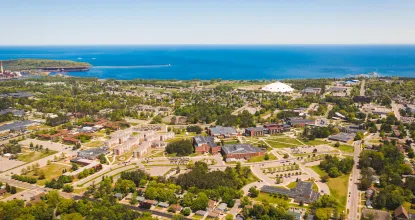1899-1911
From 1899 to 1911, biology was part of the Department of Physical Sciences, along with chemistry and physics.
1911
In 1911, it was separated and labeled the Department of Natural Science.
1940s
In the 1940s, the department offered some interesting courses, such as “Land Use Problems of the Upper Peninsula.” This course included a two-week tour of the U.P. Camps were established at the Lake Superior State Forest, Porcupine Mountains and in the Keweenaw Peninsula. In each area there were studies of the geological history of the region, the nature of the soil, the flora and fauna, and the various uses humans had made of the area’s biological resources. Around that time, Northern developed a foresty and conservation major.
1955
By 1955, Northern offered courses in biology, botany, zoology and specialized biology. All of these courses were taught by what was by then named the Biology Department. The Department of Conservation and Agriculture offered courses in forestry, wildlife, soils, dairying and horticulture.
1961
With the expansion of Northern in the late 1950s and early 1960s, there was a demand for updated, modern facilities. In 1961, Dr. Emerson Garver conducted experiments in a makeshift hut behind Kaye Hall. At the time, Dr. Roy Heath, NMU’s first research coordinator, secured funds for scientific equipment. Plans were drawn for a new science building, which would be named West Science, and its completion greatly aided in attracting faculty to the Northern campus.
1964
By 1964, biology had become “one of the strongest departments” at NMU, and continues to rank among the top five areas of study. The Biology Department offers programs for undergraduate majors and minors, as well as graduate students. The programs complement those in nursing, liberal studies, physical education and conservation. The department aims to provide an education that leads to professional careers in medicine, dentistry, veterinary medicine, allied health, wildlife biology, wastewater management, environmental control, teaching and research.
The department has three major collections which are used for instructional purposes and research. They include: the herbarium, insect collection and study skins.
Department chairs or heads:
- Elliot R. Downing, 1901 - 1911
- Samuel D. Magers, 1911 - 1918
- John N. Lowe, 1919 - 1938
- Luther S. West, 1939 - 1946
- Gordon D. Gill, 1946 - 1962
- Lewis E. Peters, 1962 - 1966
- Thomas G. Froiland, 1966 - 1997
- Ronald A. Parejko (acting), 1997 - 1998
- Neil Cumberlidge, 1998 - 2008
- Robert J. Winn, 2008 - 2009
- Patrick Brown, 2009 - 2012
- John E. Rebers, 2012 - 2021
- Jill Leonard, 2021 - present
Primary Source: A Sense of Time: The Encyclopedia of Northern Michigan University, Dr. Russell Magnaghi.
